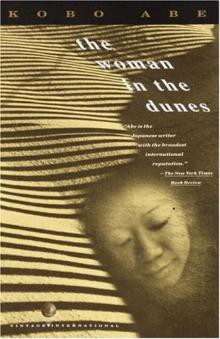Beasts Head for Home Read online
Page 2
2. In the novel, the appearance of the family is signified primarily by the figure of Kyūzō’s mother. Let me now cite in full Kyūzō’s dream of the two Kyūzōs, since his mother in fact plays a pivotal role in this dream:
For an instant, Kyūzō dreamt a sparklike dream. He dreamt of Baharin when he was very little. His mother was doing laundry behind a high wall. Crouching at her side, he played with the bubbles from the washbasin, popping them with his fingers one after another. No matter how many bubbles he popped, the infinite sky and sun whirled around in radiant gold. From over the wall, another Kyūzō, this one exhausted, peeped timidly in at the sight of them. He was utterly unable to cross over. Why must I spend my whole life wandering outside the wall?9
Here the difference between the two Kyūzōs is depicted as starkly asymmetrical. The “exhausted” Kyūzō positioned outside the wall of the home peers in at the Kyūzō located within the home’s interior, the comfort and security of which are indicated by the presence of the mother. It is significant that this image of the mother appears on the very final page of the novel, since it was the mother’s convalescence and eventual death much earlier in the narrative that were initially responsible for Kyūzō’s separation from the Japanese community in Baharin,10 thereby paving the way for his encounter with the Soviet officer Alexandrov and subsequent escape across the Manchurian plains with Kō. That is to say, if the mother’s death originally set in motion a series of events that led to Kyūzō’s “return” journey to Japan, then the ultimate failure of that journey comes to be mitigated by her appearance in the dream. For Abe, Kyūzō’s desire for Japan is seen as strangely paralleling his desire for the absent mother. Here the circularity of his desire comes into view: the loss of an original presence as manifested in Kyūzō’s belonging to a Japanese community, emblematized by his proximity to the live mother, must upon her death now be negated by returning to Japan. The return fails, let us note, not simply for the external or contingent reason that Kyūzō has come to be imprisoned in the ship’s hold (i.e., this painful event either may or may not take place) but rather for the internal, logical reason that he has in fact never previously been in Japan, and that such a return would therefore mark less a repetition than a first-time occurrence (i.e., the return in principle cannot take place). Given the mother’s intimate association with Japan, the frustration of his desire to return there finds compensation in the dream of her return, or of his return back in time, prior to her death, to her. Only in this way can the circle of Kyūzō’s relations with Japan come to be closed.
It is noteworthy in this regard that the figure of Kyūzō’s Japanese mother finds itself repeated in the three other mothers that appear in the novel, all of whom are similarly described as Japanese: Kō’s mother (whose father, Abe carefully notes, is Korean), the mother behind the walls of the Residence of Overseas Japanese Retainers, and the female mummy whose remains Kyūzō horrifyingly discovers after having finally escaped the wasteland. From Kyūzō’s perspective, this repetition results in an increased presence of the mother, for now there are four such maternal figures rather than one, but also—and by that same token—a strange dilution of his mother’s original force, since such multiplication requires that the maternal presence now be redistributed beyond the borders of her own individual life. This double movement of expansion and diminution is emphasized by Abe through the overlapping notions of repetition and substitution. Here the term kurikaeshi comes to the fore in scenes that describe the mother’s death:
After 4:00, the dormitory had become completely silent. “It’s shameful, it’s shameful,” his mother droned on repeatedly [kurikaeshite]. Leaving the room, Kyūzō began walking furtively around the empty dormitory …
“Where have you been?” his mother demanded. Her face appeared larger with swelling.
“There are mice everywhere,” [Kyūzō] replied. His voice was flabby and weak.
“It’s shameful, it’s shameful,” his mother repeated [kurikaeshita].11
The meaning of such repetition comes to be grasped only when Kyūzō discovers that his mother’s presence uncannily resists confinement to her proper identity. This he learns primarily (although not exclusively) in dreams, where the particular image of the mother comes to be caught up within the more general logic of substitution. Here we touch upon the structure of metonymy, understood in the particular sense of a “veering off of signification” that produces a potentially endless chain of replacements without ever reaching fulfillment.12 Kyūzō, that is to say, desires to return to his Japanese mother following her death but finds that this recovered image constantly slips outside itself onto others that are not her but are nevertheless somehow like her. In appearing, he observes, the mother irrevocably repeats herself otherwise. Abe is insistent in demonstrating this point, and first of all by describing how the distinction between Kyūzō’s mother and Kyūzō himself comes to be blurred.
Removing Kyūzō’s mother from the stretcher, they placed the body and bedding at the bottom of the hole. Taking a bottle from his pocket, Punsha sprinkled several drops into the grave. It smelled of alcohol. He began filling the grave with dirt. Kyūzō had the uncanny feeling that it was he himself who was being buried.13
Paradoxically, the desire to keep the mother is satisfied only on the condition that the mother herself not be kept, that she rather give herself in exchange to a proxy or agent through which alone she may reveal herself as elusively other to herself. Just as the mother comes to metonymically displace herself onto Kyūzō, so, too, will her image now slip and transform itself into the Soviet officer Alexandrov. As Kyūzō dreams,
A man with a dog stood up in the shadow of the smokestack. It was Lieutenant Alexandrov. As Alexandrov turned around, his face changed into that of Kyūzō’s dead mother, in whose eyes soup was simmering. Ladling some of the soup with his hands, he poured it into the hole of some black bread. The many men gathered around him then dipped their hands into the soup.14
In his dreams, the place of Kyūzō’s mother will also come in the course of the novel to be replaced or displaced onto the mummies, the Soviet medic Dania, and finally Sachiko, the attractive daughter of the chief clerk who lived during the war years in the same Japanese dormitory in Baharin as Kyūzō. We can observe in this metonymical chain that the notion of identity—that is, the is or and that comes to bind Kyūzō’s Japanese mother with a host of other characters—is essentially plastic. The borders that determine such accepted categories as gender and race or ethnicity, for example, are routinely violated, their parameters redrawn by a vastly more general force of identification that at any time potentially places apparently disparate things together while also differentiating those things that are typically seen to be similar. In this way, the unit of the family must, in order to present itself, cede power to a movement of repetition and substitution that effectively withdraws that presence from itself, demanding that it be remarked outside its proper limits.
3. As in so many other works by Abe, the figure of the nation-state occupies a central position in Kemonotachi ha kokyō wo mezasu. It should be recalled that Kyūzō’s very presence in Baharin is to be explained by the historical path of Japanese imperial expansion, which led to the creation in 1932 of the puppet state of Manchukuo. This hometown of Baharin appears consistently as the nostalgic object of Kyūzō’s dreams, and yet the novel clearly suggests that the fixity and stability of this childhood environment in fact originated in an act of territorial dispossession, an act that will be repeated in 1945 following Japan’s defeat and the gradual reordering of the postwar world. Again we see here Abe’s attentiveness to the shifting of borders, from the transition of Japan from nation-state to colonial empire to a Manchuria whose violent appropriation by the Japanese will be followed by the no less violent disappropriation and subsequent reappropriation by the Soviet Union before then becoming a crucial battleground over national sovereignty between the Chinese Nationalists and Communists. While it is important to di
stinguish between various instances of border appropriation—for example, the Japanese colonization of Manchuria can in no way be immediately equated with the Chinese civil war as mere examples subsumed within an abstract concept of territorial arrogation15—one must nevertheless acknowledge that any claiming of land is already an act of violence. In other words, the violent appropriation of territory does not begin through an act of invasion of land that has previously been settled or domesticated, since this earlier institution of borders that effectively establishes an interiority (home) in its distinction from an exteriority (the nonhome, foreign) is in and of itself violent. In, for instance, the scene in which Kyūzō encounters a group of Chinese youths erecting a sign that reads, “Dongbeiren de Dongbei”—northeast China (i.e., Manchuria) for the northeast Chinese—it is imperative to recognize as necessarily violent this act by which land is claimed on the part of a collective self that tautologically takes its name from that land. For Abe, the modern nation-state both inherits and substantially refines a long tradition by which such violence comes to be concealed in a political gesture of legitimation.
Abe’s intervention in this desire for appropriation takes place partly in the domain of language, for he wishes to interrupt the modern logic of the nation-state in which, for example, what is retroactively identified as Japanese land is seen to be populated by Japanese people who speak the Japanese language and contribute in their individual ways to the totality that is Japanese culture (which in turn, it must be remembered, comes to be presented as a particular object of knowledge to individuals of other nation-states within the academic discipline of Japan studies).16 The protagonist Kuki Kyūzō reveals himself to be especially sensitive to this series of mediations by which the quality of Japaneseness is established, for he hopes to identify Japanese people through the specific medium of the Japanese language in order to achieve his goal of “returning” to land that is properly Japanese (naichi). An early expression of Kyūzō’s desire can be glimpsed when he receives his travel certificate from an Eighth Route Army officer, who addresses him in fluent Japanese.
This was the first Japanese that Kyūzō had heard in two years. “Are you Japanese?” he blurted out.
“Korean,” the officer replied curtly.
For Kyūzō, the language that he regards quite literally as his mother tongue appears as an object of desire because it seems to promise the formation of communal bonds with other Japanese individuals, and yet he discovers that this linguistic mediation can always lead outside this chain of Japaneseness. Indeed, it is precisely through Kō’s recognition of Kyūzō’s desire for Japanese communality through that particular linguistic medium that he first initiates contact with him, cunningly allowing Kyūzō to glimpse the Japanese title of his book. Kyūzō’s failure to grasp the naïveté of his desire for a sense of Japanese community through the Japanese language finally leads, at the end of the novel, to his deception and imprisonment on board the ship. Hearing the men around him speaking in fluent Japanese, Kyūzō can hardly conceal his pleasure. “How about it? Look! Everyone’s Japanese!” he thinks to himself.17 Yet if his understanding of the link between national language and national identity happens to be accurate in this case, he will eventually learn that it is this same Japanese community of Japanese speakers who will forcibly prevent him from arriving on Japanese land.
In addition to his insight that language appears in modernity as a privileged articulation of the nation-state, Abe will also adroitly direct the reader’s attention to the importance of race or ethnicity in the project of national identity. Just as Kyūzō’s attunement to the Japanese language functions as a tool by which to identify other Japanese individuals, the category of race or ethnicity will play a similar role. In the following passage, for example, the desire for an established link between the Japanese language and Japanese nationality leads Kyūzō to actively project what he believes to be specifically Japanese racial or ethnic features onto Kō:
“So you’re Japanese. I thought you might be,” [Kō] whispered in a low, dry voice while shooting a glance outside. He spoke Japanese easily. When Kyūzō looked at him again, the features of a Japanese person rose to the surface on the man’s face [aratamete minaosu to, otoko no kao ni Nihonjin no rinkaku ga ukabideru].
“Are you Japanese, too?” Kyūzō couldn’t help but whisper back.
“No, I’m Chinese.”18
Abe carefully notes the strange temporality involved in Kyūzō’s identification of Kō as a fellow Japanese. It is only after this stranger first addresses him in the Japanese language that Kyūzō retroactively determines him as possessing the distinct physical appearance of a Japanese person. Such attribution of racial or ethnic features derives entirely from Kyūzō’s subjective desire, but we would be mistaken to assume that Abe regards this issue as merely one of individual psychology. On the contrary, Abe’s point is that such racism must be seen as constitutive of the project of national identity. In order to reinforce this insight, Abe will later describe Kyūzō himself as a victim of the same prejudice. This scene, the most explicitly racist in the novel, takes place at the Residence of Overseas Japanese Retainers, where from behind a wall Kyūzō surreptitiously observes two Japanese children at play.
One of the boys suddenly looked up and yelled. “Hey, there’s a beggar spying on us!”
With that, he threw a lump of mud at Kyūzō. Covering his face with his arms, Kyūzō yelled back. “I’m Japanese, you idiot. I’m Japanese!”
“There’s a beggar!” cried out the other boy toward the house. “As if Japanese people would have such dark faces!”19
The specific term for skin color Abe uses here is kuroi, meaning not only “dark” but also “black.” This determination of darkness or blackness as non-Japanese refers both to an imagined difference in skin pigmentation among Asians and a classical trope of civilizational progress, according to which proximity to whiteness signifies a decisive overcoming of primitivism and backwardness in favor of cultural advancement. In this scale that correlates skin color with the relative degree of modernization among peoples, one can discern during the war years a pronounced “tendency among Japanese to try to distance themselves physically from the ‘darker’ peoples of Asia,” as the historian John W. Dower writes.20 It is in this particular context that we must understand Abe’s response to the history of Japanese racism, which of course adopted many of the tenets of “Western” racism. Not only is Kyūzō identified by his compatriots as non-Japanese on account of his darkened skin (owing to his prolonged exposure to the elements while crossing the Manchurian plains); Abe also represents other Asians as possessing lighter skin relative to the Japanese characters in the novel. We can see this in the figure of Zhao, the Shenyang broker and business associate of Ōkane’s whose complexion is described as “whitish” (iro ga shirokute), as well as in the Chinese Nationalist officer General Bai, whose face is “shaven clean and white” (shiroku) and whose very name means “white” in Chinese.21 Here Abe’s strategy consists in effectuating a certain historical reversal not in order to argue that Chinese are in fact empirically lighter than Japanese but rather so as to call attention to the underlying presence of the category of race in the discursive formation of the nation-state.
4. By its very title, Kemonotachi ha kokyō wo mezasu alerts us to the presence of the animal in Abe’s work. What precisely is accomplished in referring to Kyūzō and Kō as “beasts,” as seems to be the intention here? First of all, it is important to note the centrality of the figure of the animal in the history of racist discourse. In this novel about the modern primacy of the nation-state, Abe suggests that the home afforded by the security of national affiliation has come to define the human in its distinction from the animal. Once again it is a question of borders, the lines by which the opposition between the self (interiority, identity) and other (exteriority, difference) comes to be fixed. “Outside the wall people are lonely,” Kyūzō reflects at the end of the novel, “forced to bare their tee
th like apes in order to live. They can only live like beasts.”22 Beyond the boundary of the particular nation-state can be found not only the foreigner, then, but also the animal, broadly defined. The animal is the beast or brute whose brutality condemns it to exist outside the limits of civilization. The quality of whiteness that determines the human includes within it those faculties that are believed to be the sole property of humanity in its essence, such as reason, consciousness, language, and moral sensibility. Given the internally mediating notion of humanity, however, the concretization of this otherwise abstract universal (in Hegelian language) can take place only through a movement of particularization. That is to say, humanity must concretely instantiate itself in a particular form that in some way embodies or incarnates the essence of humanity in general. And this, precisely, is the historical meaning of whiteness. Let me insist that this term must be lifted from all empirical content in order to grasp its significance in modernity as the privileged exemplar of reason, consciousness, language, and moral sensibility. Following this framework in its pure duality, to be human is to be white while darkness or blackness resides strictly on the side of the animal.

 The Box Man
The Box Man Beasts Head for Home
Beasts Head for Home The Face of Another
The Face of Another The Woman in the Dunes
The Woman in the Dunes Secret Rendezvous
Secret Rendezvous The Ark Sakura
The Ark Sakura The Ruined Map
The Ruined Map